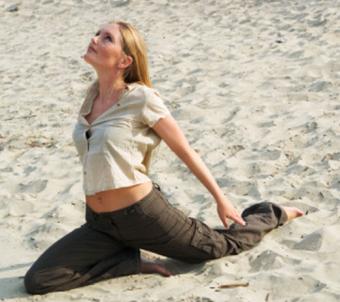
The pigeon yoga pose, or eka pada rajakapotasana, is a four-part posture. As you continue to expand your yoga practice, you can work through each stage with a continued focus of intention.
About Pigeon Yoga Pose
The root of kapotasana, kapota, means, "pigeon" or "dove" in Sanskrit. The full name of this posture stands for one-legged king pigeon, and the final stage of the posture, yogis arc their extended leg up and clasp the foot behind the head, like this.
The benefits of practicing the pigeon yoga pose are:
- Revitalized internal organs
- Extended stretch for the thighs, hips, and groins
Advanced practice also opens the chest and releases shoulder tension.
Step into the Pose
Instructions for Pigeon Yoga Pose
- Begin on all fours
- Pull right leg up, close to the back of the right hand.
- Angle your foot to the left
- Slowly extend your left leg back, and sink your pelvis downward
- Straighten the back as you rise above the extended left leg
- Support yourself with straight arms alongside the body, and sink even further down into the pose
For more instructions on moving into the first stage of pigeon yoga pose, visit Yoga Journal.
Beginner
Tight hips and thighs restrict movement in this pose. Use a bolster or rolled blanket under the reclining leg at the front of the pelvis as you increase flexibility.
Support yourself with your hands until you achieve balance.

Intermediate
As you melt into the floor, bring your arms overhead, palms together, shoulders down, like this. If comfortable, tilt your head back, but only for a short period of time, because even though the tilt elongates the chest and neck, it decreases blood flow to the head.







